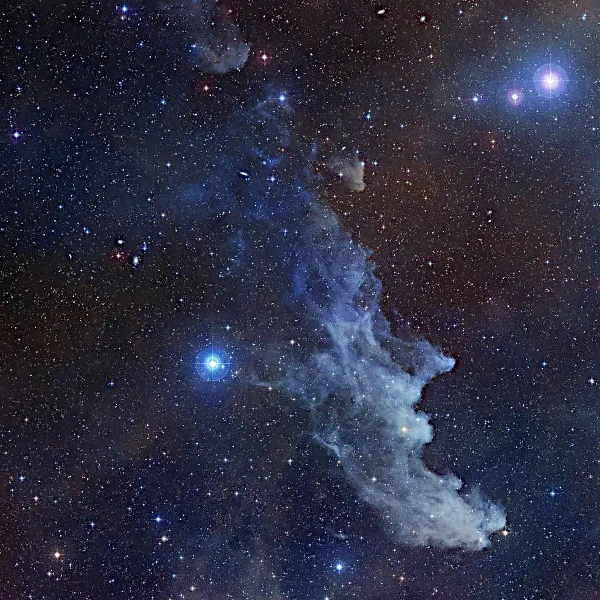
The Witch Head Nebula (IC 2118) is a dark cloud of gas and dust located in the constellation Orion, near the Flame Nebula (NGC 2024). Its shape, resembling a frightening human profile, makes it an iconic object in visual astronomy, while offering a natural laboratory for the study of molecular clouds and star formation.
The cloud obscures the light from background stars and measures about 3.5 light-years long. Its density ranges from 10³ to 10⁵ particles/cm³, and its temperature is very low, around 10 to 20 K. These conditions favor local gravitational collapse and the formation of new stars.
N.B.:
The measured densities and temperatures come from radio and infrared surveys using CO and ammonia (NH₃) as molecular tracers.
The Witch Head contains mainly molecular hydrogen (H₂), CO, ammonia, and silicate and carbonaceous dust. The presence of these complex molecules is an indicator of the advanced evolutionary state of the cloud and its potential for planetary system formation.
Radiation from surrounding massive stars and internal turbulence sculpt the cloud and create pressure gradients. The densest areas can collapse under their own gravity, initiating the formation of new stars and proto-planetary systems.
N.B.:
Collapsing regions can be observed via infrared and radio emissions, which trace the density and movement of molecular clouds.
Data comes from optical, infrared, and radio telescopes, including Hubble, ESO, and Planck. Multi-wavelength images allow mapping of density, temperature, and chemical composition.
| Property | Value | Observation / Instrument | Reference |
|---|---|---|---|
| Distance | ≈ 1,500 light-years | Optical and infrared telescopes | NASA / Hubble, 2020 |
| Length | ≈ 3.5 light-years | Dust density maps | ESO, 2019 |
| Density | 10³ – 10⁵ particles/cm³ | Radio spectroscopy (CO, NH₃) | Megeath et al., 2012 |
| Temperature | ≈ 10 – 20 K | Far infrared | Planck Collaboration, 2018 |
| Composition | H₂, CO, NH₃, silicate and carbonaceous dust | Multi-wavelength spectroscopy | Hollenbach et al., 2009 |
Sources: NASA, ESO, Hollenbach et al., 2009
The iconic silhouette of the Witch Head illustrates the complexity of molecular clouds and the visual beauty of the Universe. It allows the study of the physics of dense clouds and star formation in extreme conditions, while inspiring human imagination.